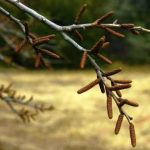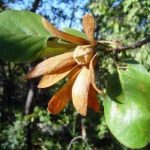TREE LIFE
February 1984
MASHONALAND CALENDAR
Tuesday February 7th : Botanic Garden Walk. Meet in the Car Park at 1645 for 1700 hours.
Sunday February 19th : A visit to Boisserain Farm, Wedza North, the home of Richard Moore. The drive into the Wedza area is very pleasant and one sees many fine trees, en route. We saw several Clerodendrum glabrum in full flower en route. On the farm there is a large mixed variety of trees of woodland, riverine, anthill, et al. A species count approaching 80 was achieved without great effort. This is testimony to Richard’s keen wildlife interest and concern for conservation especially in the non arable areas. A bus from Harare has been arranged which will leave Monomatapa Car Park at 0830 hours. Fare $13,50.
MATABELELAND CALENDAR
Sunday February 19th : Again, later in the month than usual, but unavoidable. We hope to return in March to our regular first Sunday. Go along the Burnside Road, turn left into Northway and go to the end of the tarmac. From there we can walk to an interesting kopje area. 0830 hours.
CHEGUTU CALENDAR
Sunday February 5th : Our next outing will be on uSasa Farm, home of Mr. and Mrs. Tom Brierley on 5th February, 1984 at 1000 hours. To get there take the Seigneury Road out of Chegutu for 2 miles and turn right into Hilldene Road. Travel down this for about 2 miles and turn left at the first major road, which is not signposted. The farm is on the right about one and a half miles down. In the afternoon we will be going to Knysna Farm which is nearby.
SUNDAY 18TH MARCH, 1984 : ANNUAL GENERAL MEETING
Notice is hereby given that the 34th Annual General Meeting of the Tree Society of Zimbabwe will be held on Sunday 18th March, 1984 at 12 noon at Twentydales Farm, Widdicombe Road.
AGENDA:
- Notice convening the meeting
- Minutes of the last A.G.M., to be included in next Tree Life
- Matters arising there from
- Chairman’s Report
- Treasurer’s Report
- Election of Officers
- Any other business
BOTANIC GARDEN WALK JANUARY 3RD 1984
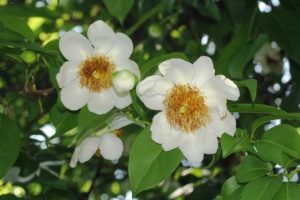
Oncoba spinosa flowers. Photo: Bart Wursten. Source: Flora of Zimbabwe
We began our examination of the FLACOURTIACEAE by looking at the flowers on Oncoba spinosa, which superficially resemble those of an English dog rose. The family features to note are the variable number of overlapping petals arranged in a radial symmetrical pattern; a distinctive mass of yellow anthers in the centre; and a superior ovary. The ovary of Oncoba swells into a guava sized fruit which has turned our household into Oncoba sniffers as the dried fruit keeps its confectionary smell. Oncoba grows in the Zambezi valley where it is widespread in different habitats but never common. We later saw the flowers of Bivinia jalbertii which stick up from the horizontal branches. Although these lack petals they also have the mass of anthers protruding out of the flower. There is now a rare tree on Nyoni Hills, its straight trunk make it suitable for tall telephone poles. Gill Masterson says the wood is very borer resistant and so was used as rafter beams in the Rhino Hotel. There are a few plantations of it at Chiredzi. It was interesting to contrast these erect flower stalks with Homalium dentatum, which we recognized immediately as a FLACOURTIACEAE, planted on Trevor Gordon’s farm. Here the flowers were carried on stalks that hung down from the horizontal branches. H. dentatum is a dry forest edge species at Marahwa’a Hill near Mutare, Wedza and Matopos. Near the car park Tom does have a specimen of the rare Homalium abdessammadii which grows alongside the path in the rain forest at Victoria Falls.
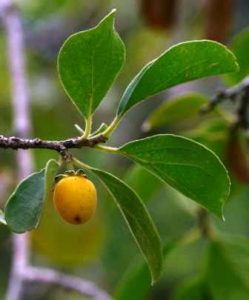
Dovyalis zeyheri. Photo: Bart Wursten. Source: Flora of Zimbabwe
The walk was somewhat interrupted by a Dovyalis lispidula which was so covered in ripe fruit that the branches hung low with their heavy burden. We all began engorging on the bright red, tasty fruit. Tom thinks this specimen may be dying as such heavy fruiting is very unusual in its natural habitat on the alluvium of the Sabi Valley. We may remember that AGM when Mrs. McBean had made jam from Dovyalis zeyheri, the oval kei apple. We are familiar with the leaf miner tracks we commonly see in its shiny leaves. At Trevor Gordon’s farm we were able to experience the fetid smell of the leaves of D. zeyheri. Near the Anthocleista grove in the gardens we saw D. macrocalyx with minimal leaf serrations and a large persistent calyx which becomes shredded or fimbriated. D. macrocalyx grows in the drier Chipiti forest in the east and on Marahwa’s Hill. D. caffra is common around Bulawayo but as the fruit makes excellent jam, the plant is widely cultivated, even in Australia, California and along the Mediterranean, so one is never sure where it has become naturalized. At the base of the new stream we saw D. lucida, with a broad leaf and short petiole. Unfortunately the borehole water in the gardens is very salty, possibly due to the low water table. As a result the leaves of D. lucida had to be polished to show their usual glossy sheen. This plant grows in high forests in the Vumba.
The FLACOURTIACEAE all have alternate leaves which may be entire but often have crenate margins all round the leaf. Possibly one of their most consistent features is the variability. The most obvious character of the widespread Flacourtia indica is that each specimen is never the same as the last one you saw. Some have large spines and furry leaves with toothed margins, but all of these features may be entirely absent or partially present. Kigelia africana plays an equally deceptive game, and yet with experience both species are ‘fairly’ unmistakable.
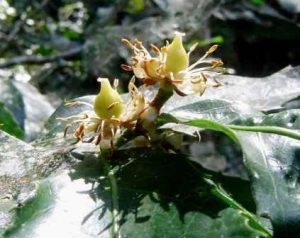
Rawsonia lucida. Photo: Bart Wursten. Source: Flora of Zimbabwe
The opposite leaves of Casearia battiscombei are carried in a flat plane on zig zag branches, an unmistakable growth form. This is a dry forest canopy tree at Mt. Selinda and the Vumba. Apparently the small flowers sit in tight clusters on top of the branch. Rawsonia lucida grows in a similar habitat but has holly like serrations on its tough leaves. The bark is mottled in different browns. The fruit is a wooden capsule smaller than a tennis ball which we saw splitting into 3. Tom was prepared to sample the flesh which he claimed is sweet and edible.
Scolopia stolzii is an impressive little tree that flushes out bright red like a burning bush. It grows along streams in the Honde Valley where it is unmistakable from a distance. Apparently it grows to a large tree in Malawi. Within the high altitude forest section we saw the other species, S. zeyheri. this grows with Curtisia in the dry forest at high altitudes as well as at Ruwa and around Harare stretching south-west towards Bulawayo. This is a fast growing tree which can develop the spines so often seen in members of the FLACOURTIACEAE.
Trimeria grandifolia has a round mulberry leaf and grows in both dry and wet forests of the eastern highlands, often associated with Afrocrania and growing at Cecil Kop. Aphloia theiformis is also growing in the high altitude section at the Botanic Gardens. This small leafed pioneer with fine serrations on the margins can grow to 1 400 m, along streams and as a forest edge species at Inyanga. Some specimens are large trees with a 1 m trunk diameter.
We must again thank our host, Mr. Tom Muller for sharing his garden and experience with us.
-Kim ST.J. Damstra
OUTING TO AUDLEY END FARM : 15TH JANUARY 1984
This month Harare members were once again privileged to visit Audley End, the home of Trevor Gordon in the Darwendale District. Trevor had been a Society stalwart probably since before the Vice Chairman was even thought of. He told members on their arrival that he has been on the farm since 1950 and the area which he was going to let us explore had been preserved since then.
With the same efficiency obviously employed in the running of the farm, Trevor had organized a truck with commodious seating accommodation which took us through lands of fine tobacco to a fenced paddock. En route, however, we saw a 15 year old Albizia tanganyicensis gown from seed which was peeling its bark in the characteristic orange papery sheets.
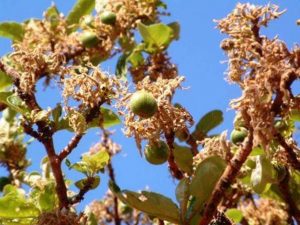
Vangueriopsis lanciflora. Photo: Rob Burrett. Source: Flora of Zimbabwe
We split up into three groups. I was fortunate to be with Trevor which meant that very little of interest was missed. We first stopped to look at Vangueriopsis lanciflora and were soon able to compare this with Vangueria infausta. These are always apt to confuse us and this occasion was no exception. Neither bark had the ‘red rub’ feature and the memory jolt also failed. “Vangueria is hairier”. Trevor thought Vangueriopsis had more prominent veins on the underside. However with due respect, I failed to detect much difference. For me the discernible differences were that the leaves of Vangueriopsis tended to be more folded along the mid rib and the branches appeared less “layered”. Anyway that’s my theory.
On a low anthill we come across Grewia flavescens in yellow flower. This is the scrambling Grewia which has ‘square’ stems. Trevor has seen it growing as a liane in forests. For contrast we also saw G. monticola with the distinctly pale underside to the leaf.
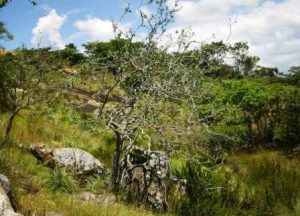
Euphorbia matabelensis. Photo: Bart Wursten. Source: Flora of Zimbabwe
Next, a case of ‘failing to see the tree for the bark’. I thought I was looking at a Commiphora africana, for its bark was peeling in small flakes showing a green under bark. Stepping back a few paces my error became apparent, for the zig zag branching clearly showed that this was indeed Euphorbia matabelensis. If any confirmation was needed it was amply supplied by the copious flow of latex from a broken leaf. Later we did see C. africana and compared it with a nearby C. mollis. C. mollis also has flaking bark which is of an orange hue and does not have the same small papery flakes. The margins of the leaflets are entire unlike those of C. africana which are toothed. Later still we saw C. mossambicensis with its dark purple brown bark which does not flake at all but rather looks like gooey toffee. The leaflets are reminiscent of an apricot leaf.
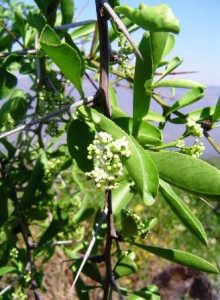
Maytenus heterophylla. Photo: Bart Wursten. Source: Flora of Zimbabwe
Because it was obviously growing, Zanha africana did not have a clear ‘ball and claw’ bud, but the general leaf appearance was right and the bark was flaking, as usual, in roundish flakes, leaving pinkish blotches. A tree which had us guessing for a while was given away by its almost ever-present flower buds. This was Tricalysia angolensis. A useful tip pointed out by Trevor is that these buds, more often than not, come out in bunches of threes, a feature worth remembering.
In an anthill community was Maytenus heterophylla, its fascicled, emarginated fresh green leaves carried at the ends of short boss like branchlets. M. senegalensis on the other hand, was in the open and spreading, apparently, by suckers or runners. The blue green leaves with pink petioles are quite different. Another tree which tends to spread in a similar fashion is Catunaregam spinosa and here was a typically short scrubby ankle scratcher. Later in the afternoon, however, near the house, they were seen as very substantial trees.
The sight of an Erythrina abyssinica prompted discussion as to the difference between this and E. latissima. Trevor’s view is that the leaves of E. latissima are significantly larger and as a general rule will have thorns on the leaves and not merely on the petiole. Another point to look out for.
On a low kopje were a couple of fine specimens of Afzelia quanzensis in full leaf but not a flower or seed to be seen. Speaking of size we did see a truly outsize Diplorhynchus condylocarpon with a trunk which I believe would have required two people to encircle it with their arms. Still on the size theme, we saw, and smelt, some unusually large Clerodendrum wildii. Apart from the strong smell of the leaves and the purple petioles make this distinctive.
Dotted about the area we walked in were a number of Cassia singueana from which strange brown bags hung. The story behind this, which Trevor has told before, is worth repeating. These are the communal homes of the caterpillars and pupae of a moth which is exclusive to C. singueana, the larvae feeding on the tree, then pupating in the “bag” which gradually grows in size. The adults feed on, or at least frequent the flowers and in due course the eggs are laid on the tree. The sighting of the “bag” is sure identification of C. singueana.
A number of trees were in flower. Both Bauhinia petersiana and B. thonningii had white flowers, the former being particularly conspicuous. Pavetta gardeniifolia’s flower was about twice the size of that of P. schumanniana which, though not flowering here, we have seen in flower elsewhere this season. From the flower tube a long style which is about twice the length of the flower protrudes. We saw Psorospermum febrifugum while the other parties collected its red ‘holly’ berries. Ozoroa insignis was also both flowering and fruiting. Some lucky members saw Swartzia madagascariensis in flower, but most of the trees had young ‘snake bean’ pods. Trevor has noted no regeneration of Swartzia.
We saw three species of Ochna, O. puberula with small leaves O. schweinfurthiana with similar, larger leaves which are distinctively serrate, and O. pulchra with not so serrate leaves, but with peeling bark revealing the pale smooth under bark.
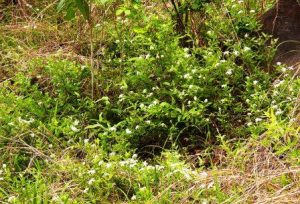
Jasminum stenolobum Photo: Bart Wursten. Source: Flora of Zimbabwe
For me, one of the highlights of the walk was at the end when we climbed another small kopje and were shown a small tree/bush/scrambler with fat, juicy, shiny black berries whose taste deteriorated as one continued to suck the pips. This was, in fact, Jasminum stenolobum which I do not recall having seen elsewhere. It belongs to the family OLEACEAE.
At lunch time we retired to a camp site under spreading Musasas and after lunch Trevor held a brief “clinic” reviewing what had been seen or not seen what was on the farm, etc. This was a popular idea which we will endeavour to repeat.
After lunch we went to the kopje behind the house and saw Trevor’s plantings embracing a multitude of trees, most of which do not even appear on our tree list. Some of the tantalizing exotic sounding names included Commiphora merkeri, the zebra bark, Spirostachys africana, the tamboti, Terminalia gazensis of Christmas Pass, Gyrocarpus americanus from the lowveld which has double bladed helicopter rotors for seeds and gets it specific name because the same species occur in America. And many more…..
Once again a big thank you to Trevor and his wife for organizing yet another memorable day on Audley End
-J.P.Haxen
MATABELELAND NOTES
For our January meeting Val Deas invited us to her home at Matseumhlope which adjoins a most attractive area of open woodland. On Sunday it was looking at its best, green and fresh and spattered with wild flowers.
This was the first outing since the “new look” as decided at the AGM was tried out. Dora Webb gave a talk on Vitex payos, stressing the family and those plants belonging to it, and Val Deas spoke on diplorhynchus condylocarpon and the very interesting family APOCYNACEAE. This led to a general discussion which proved valuable and stimulating.
While we were looking at a fine specimen of Cussonia arborea we noticed a very young Cussonia growing close to it, the leaves of which were palmate like C. natalensis. Apart from remarking that the two species were growing very close together we forgot about it until we came upon a second example of the same thing. This time the young plant appeared to be growing directly out of the trunk of the C. arborea at ground level. Is there any significance in this?
Numerous Pterocarpus angolensis grow in the area and we were distressed to see how many had been cut down and the trunks just left lying on the ground. I came upon a possible explanation the very next day when I saw, for sale, in a large department store, a portion of trunk, about half a meter long, the side of which had been carved into a crude human face, a most unlovely object. There were two of these, both quite costly. What can be done about this?
CHEGUTU NOTES
At the invitation of the newly formed Chegutu Branch of the Tree Society several members from Harare visited Thistle Farm, off the Chakari road Suri Suri area, on the 8th January 1984, the home of John and Janet Young.
The terrain was flat sandveld, very drought stricken, interspersed with large, very wide but not high anthills, supporting the usual amazing variety of vegetation. In woodland along the farm road we saw a small stand of Euphorbia matabelensis, EUPHORBIACEAE, slender grey trunks and branches usually spine tipped – these have profuse milky sap, an irritant used by the piccanins as bird lime. I saw one violet tree, Securidaca longipedunculata POLYGALACEAE, plenty munondo, Julbernardia globiflora, CAESALPINIACEAE, plenty of Lannea discolor, the ‘live long’ ANACARDIACEAE, and many many other trees which grow on the Highveld. But on the antheaps we saw Combretum mossambicense, COMBRETACEAE, with rounded paired leaves, tending to climb, if in fruit it has 5 wings. A slender young Markhamia acuminata, BIGNONIACEAE, with paired opposite compound leaves and a terminal leaflet was there sterile for all but one tiny pod, these can grow up to 15 inches long. This tree has beautiful yellow trumpet flowers with a maroon mark, but none was seen.
Manilkara machisia, SAPOTACEAE, with its simple leaves widest above the middle and arranged in rosettes was there, definitely lowveld. Ormocarpum kirkii, a small tree with tiny compound leaves, PAPILIONACEAE, was there and plentiful Bauhinia petersiana, CAESALPINIACEAE, in large white flowers with narrow crinkled petals, pink stamens and lobed leaves, in large bushes a bit bedraggled now. Cassia singueana, the winter flowering cassia and Cassia abbreviata, which grows into a biggish tree which has very long pods, CAESALPINIACEAE, were both there, no flowers, very little fruit. The Cassias have alternate compound leaves, but no terminal leaflet, the winter flowering cassia is often seen around Harare.
A special not found in Harare was seen growing in shade at the foot of a granite outcrop, a small spreading bushy tree with grey green leaves, elliptic, short petiole, between 1 and 2 inches in length and with a few miniature Combretum like fruits on slender pedicels, this was Pteleopsis anisoptera, COMBRETACEAE. These plants can grow into tall trees of 20ft or more with erect boles, especially on ant heaps, and in a good season are profusely covered with bunches of many fruits.
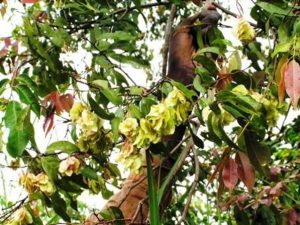
Pterleopsis anisortera. Photo: Jos Stevens. Source: Flora of Zimbabwe
The second species from Suri Suri area as opposed to Harare was the really rare fig Ficus nigropunctata, MORACEAE, this has seldom been found but has been collected before in this area and also near the Umfuli river. The whole appearance is rather somber, the leaves are much longer than wide, rounded to heart shape at the base with a slightly toothed margin narrowed to a tip the darkest green above, grey green below, it was growing in shade with the Pteleopsis. This fig had been seen near the Umfuli River, long and leggy, growing out from inside the rotten bole of a Mufuti – Brachystegia boehmii, CAESALPINIOIDEAE.
In the afternoon next to the house, we were shown in woodland a splendid ebony tree, Diospyros mespiliformis, EBENACEAE. It is about 50 ft high with erect unbranched bole up to about 15 ft. and then a great crown of ascending spreading, evergreen leafy branches and dark bark a lovely specimen, often seen topping many hills but not nearly so large as this. Here and there was Strychnos innocua, LOGANIACEAE, in twin unripe green fruits, small now, but which grow out into big bluey green to orange.
I found Canthium frangula, RUBIACEAE, not often seen near Harare, a small bush with elliptic leaves widest at the centre and with rather blunted tip. It has strong, dark paired opposite thorns growing almost at right angles to the stem.
Altogether a most interesting day. The Chegutu members are fortunate to be living in such a varied vegetative area, with rare plants to locate and collect.
Our thanks to the Chegutu members and to Janet and John Young for their very kind hospitality and interesting day which included a glimpse of Janet’s Home Weaving Centre, part of the activities on Thistle Farm.
-Gill Masterson
ROOT NOTE : Subscriptions. We wish to remind members that 1984 subs are now due. Single membership is $5.00 and family or institutional membership is $6.00. Please forward early to P. O. Box 2128, Harare.
ROOT NOTE : In a recent letter, former Harare member Dix Airey, urges any members who may be visiting Durban area and would like to see some local vegetation, to contact them. The phone number is Durban 812640 and the address is 270 Queen Elizabeth Avenue, Manor Gardens, Durban.
PHILLIP HAXEN, CHAIRMAN.










